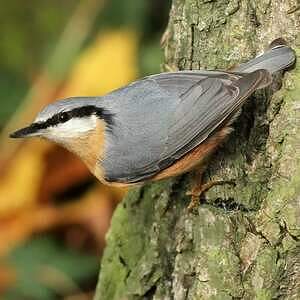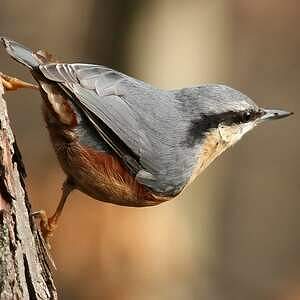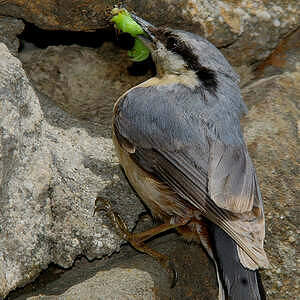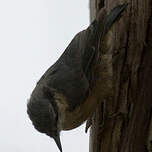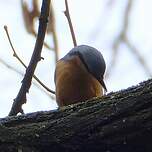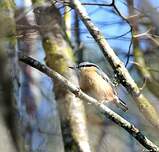Eurasian Nuthatch
Sitta europaea - Sittelle torchepot
Identification
The Eurasian Nuthatch is an easy bird to recognise by its plumage and behaviour, and even more so since it is usually the only one of its kind present at a given location. Sexual dimorphism is weak and the juvenile is barely more dull than the adult. On the other hand, the general aspect can be very different depending on the subspecies, of which there are 21. We will here describe the subspecies caesia which occupies temperate Europe and to which an observer is usually confronted. The upper parts, from the beak to the tail tip, are a fairly light grey-blue, the blue standing out particularly in good light and under a blue sky, the grey dominating in the undergrowth, the bird's habitat. The wings and outer rectrices (the centre feathers are of the same colour as above the body) are of a dark grey-brown with grey-blue fringes which make the bird's plumage uniform when at rest. It is only in flight or when preening that one can see that the 3 pairs of outer rectrices have white tips. The lower parts are rufous from the throat to the abdomen, the intensity increasing from front to back. The throat and sides of the head are white. The flanks are distinctly chestnut, especially in the male. The two-coloured subcaudal feathers, white and chestnut, have a scaly aspect. A typical pirate black band runs on either side of the head, from the beak to the wing attachment passing through the lores and eyes which it encloses, then extending backwards in a curved line. The dark eye is barely visible, being included in the band. The long, pointed beak is black with the base of the lower mandible a pale grey-blue. The feet with very clawed fingers are greyish to brownish. The female has a less marked band, a paler underside, particularly the flanks, but the distinction is not easy.The juvenile resembles the female, but its headband is less defined and is shaded with brown, its plumage is more dull, and its legs are more pale. The subspecies mainly differ in size, the intensity of the grey of the upper parts and the colouration of the lower parts, which lighten following a gradient from north to south and from east to west until they become almost all white in the north and east. Therefore, in birds from the north of Japan, the chestnut is limited to the undertail coverts, and the rest of the underside is all white. Some subspecies show a slight white eyebrow.
Subspecific information 21 subspecies
- Sitta europaea europaea (n and e Europe)
- Sitta europaea sinensis (nc and e China)
- Sitta europaea formosana (Taiwan)
- Sitta europaea asiatica (sw, sc Siberia, n Kazakhstan and w Mongolia)
- Sitta europaea seorsa (nw China)
- Sitta europaea baicalensis (e Siberia, c Mongolia)
- Sitta europaea albifrons (ne Siberia and the n Kuril Is.)
- Sitta europaea takatsukasai (sc Kuril Is.)
- Sitta europaea sakhalinensis (Sakhalin I.)
- Sitta europaea clara (s Kuril Is., Hokkaido. n Japan.)
- Sitta europaea amurensis (Russian Far East, ne China and Korea)
- Sitta europaea bedfordi (Cheju I.. off South Korea.)
- Sitta europaea hondoensis (Honshu to n Kyushu. Japan.)
- Sitta europaea roseilia (s Kyushu. extreme s Japan.)
- Sitta europaea caesia (w, c and se Europe)
- Sitta europaea cisalpina (Switzerland, Croatia, Italy and Sicily)
- Sitta europaea hispaniensis (Portugal, Spain and n Morocco)
- Sitta europaea levantina (s Turkey, n Syria and n Lebanon)
- Sitta europaea caucasica (ne Turkey to sw Russia)
- Sitta europaea persica (se Turkey, n Iraq and w Iran)
- Sitta europaea rubiginosa (n Iran and Azerbaijan)
Foreign names
- Sittelle torchepot,
- Trepador azul,
- trepadeira-azul,
- Kleiber,
- csuszka,
- Boomklever,
- Picchio muratore,
- nötväcka,
- Spettmeis,
- brhlík obyčajný,
- brhlík lesní,
- Spætmejse,
- pähkinänakkeli,
- pica-soques blau,
- Hnotigða,
- kowalik (zwyczajny),
- dzilnītis,
- brglez,
- Поползень,
- ゴジュウカラ,
- 普通䴓,
- nötväcka,
- 茶腹鳾,
Voice song and call
The Eurasian Nuthatch is very vocal. Its voice is unique and cannot be confused with any other in European forests. The usual call is a sequence of Tuit emitted at a rate of 2 to 3 notes per second, often repeated for a long time, Tuit Tuit Tuit Tuit...). Other calls noted are Tui tut or Tui tutut repeated, isolated tiup or in series tiup tutut, and more in the same way. In flight, it emits sharp lonely tsit notes. The song also consists of the regular repetition of identical syllables, ascending tuuiits. The rate of emission can accelerate up to making a trill. Then it is a monotonous tu u u u u u u u up or a slightly decreasing one.
Habitat
The Eurasian Nuthatch is predominantly a forest bird, but it can also be found in all non-forest arboreal habitats like parks and gardens, including in cities, old orchards, arboreal hedges, poplar groves.
Behaviour character trait
The Eurasian Nuthatch is one of the most vocal passerine birds in the springtime forest. It is impossible to miss. Once spotted, its grey-blue and rusty plumage allows for easy identification. Its long and pointed beak could make it look like a small woodpecker, but its silhouette is very different. Generally, what is remembered most of all about it is its arboreal behaviour. It is very active and agile in trees. Its robust legs with 4 hooked nails allow it to grip the most smooth bark with ease, thus allowing it to move in all directions along tree trunks and branches, even with its head down, something woodpeckers never do.
The nuthatch is a sedentary bird, present all year in its forest, thanks to its seed-eating diet in winter. At this season, it does not hesitate to go to the ground to pick up acorns, beech and other tree seed which it consumes. This love of seeds causes it to visit bird feeders, as long as they are close to a wooded area. An easy solution for it. It can be aggressive towards other birds there. Like many, it loves sunflower seed. To open a hard seed it uses a method like the tits and woodpeckers, striking the seed with its beak held fast between its legs or held by a crack in the bark. It is capable of cracking hazelnuts. The nuthatch is not a gregarious species. Breeding couples are highly territorial and do not tolerate intruders. On the other hand, once the breeding season is over, their territoriality melts away and smaller, looser groups, are formed on a family basis. It can join tit parties, typical of mid-season forests.The Eurasian Nuthatch, hence its specific name, displays another behavior which is to build walls around the entrance of the nesting cavity in order to reduce its size and thereby exclude any annoying competitors such as starlings.Flight
With its wide and round wings and its short tail, the Eurasian Nuthatch has a distinctive silhouette. Nevertheless, it has a fast and direct flight when changing trees or branches. Unlike the Crag Martin on its rocky walls, the Eurasian Nuthatch does not use its wings to move in the trees. It keeps them close to its body.
Dietfeeding habits
The Eurasian Nuthatch is very active in searching for food in all layers of the forest, from the ground to the ends of branches in the canopy, according to the seasons and the availability of resources. It has a mixed diet, insectivore in the summer and granivore in the winter. As soon as the spring insect population appears, it actively searches for phytophagous or bark beetles, Coleoptera, Lepidoptera and other arthropods such as spiders. The young in the nest are mostly fed with it. Lepidoptera play a major role here, as do tits, so the nuthatch must play an important but perhaps insufficient role in controlling folivorous and processionary caterpillars.
Its powerful beak enables it to dislodge prey living in the diseased or dead parts of trees. As the vegetation dies, it switches to a granivorous diet and turns to the seeds of trees or shrubs in its territory, without exclusivity. The diet then depends on the forest context, deciduous or coniferous. Hard-shelled seeds are broken with their beaks. Like many other species, they hide food on the ground or in trees for days when food is scarce. It does not disdain the forms of insect resistance, cocoons and other chrysalises, which it discovers. Being opportunistic, it knows how to make use of resources that mankind offers, either willingly or not. So in the forest it is a regular at hunters' grain points. It can also leave its forest to collect seeds, such as sunflower, its favorite, in a nearby field. Of course, it follows tits to winter feeding posts where it also enjoys sunflower. Like them, it stores them up.Generally, she does not consume on site but rather takes her seeds away to snap them on a woody vegetation.Reproduction nesting
The Eurasian Nuthatch is monogamous and territorial. As such, the couple resides in its territory year round. Breeding usually takes place in the plains in April and May, although it tends to be more delayed in higher altitude or latitude areas. The Eurasian Nuthatch nests in cavities, meaning they make their nest in a hole. The female mostly invests in the nesting process, she chooses the site and then prepares it. It is most often a natural cavity in a trunk or branch and is usually an old woodpecker's dwelling. However, if necessary, it can be a cavity in a rock wall or other structure.
Bricks boxes can also be suitable. The bird does not make the cavity itself although its beak could do so, rather it reduces the size of the entrance of the cavity with mud to ward off potential competitors and predators, such as the Starling, European Green Woodpecker, and Dormouse. This process takes her a few weeks. Thankfully she will be able to reuse the nest afterwards. The nest is made up of mostly bark chips which she cuts and collects from the surrounding area. On this base, she lays between four and nine white eggs that are gently speckled red and she incubates them for around fifteen days. After hatching, the young chicks will be fed by both of the adults at the nest for over three weeks, which is long for a small passerine bird. After leaving, they will still depend on their parents for another one to two weeks. All of this means that a second breeding event is rare. The Eurasian Nuthatch is a common species that can reach high densities in the most suitable habitats. Literature states that the range can be from three to seven breeding couples per hectare, which is very high and likely rare.Most of the time, the density must be 1 individual per hectare or less in aged deciduous stands. In conifers, it is much less.Geographic range
The Eurasian Nuthatch's range extends across all of Eurasia, from the Atlantic to the Pacific at middle latitudes. To the north, they are absent from Ireland, northern British Isles, 2/3 of Scandinavia and the Arctic and Subarctic Siberia. They are very rare in Finland. To the south, they are absent from Africa, except Morocco's Atlas Mountains, the Arabian Peninsula, all of Central Asia, and most of China. They are present in Turkey and Northern Iran. To the East, they can be found from Kamchatka to Formosa, including Sakhalin, the Kuril Islands, and the Japanese archipelago. On the continent, the range reaches across the eastern part of China as far as Hunan. Twenty-one sub-species are found within this vast area. Birds in temperate latitudes are sedentary. However, those located in Northern regions can be forced to migrate due to winter's severity and, especially, due to food scarcity caused by bad mast of trees. They can then do so in large numbers, and over great distances. For example, ssp asiaticus have been able to reach Finland.
Threats - protection
IUCN conservation status
concern
in the Wild
threatened
evaluated
The Eurasian Nuthatch is a common and widely distributed species. Therefore, it is not globally threatened at the species level. It has even been reported to be increasing since the 1960s in Europe, perhaps in correlation with climate change.
Sources of information
- IOC World Bird List (v15.1), Gill, F and D Donsker (Eds). 2025-12-07.
Other sources of interest
 Specification sheet created on
08/07/2023 by Jean François
Specification sheet created on
08/07/2023 by Jean FrançoisTranslation by AI Oiseaux.net
© 1996-2025 Oiseaux.net
- Accipitriformes
- Aegotheliformes
- Anseriformes
- Apodiformes
- Apterygiformes
- Bucerotiformes
- Caprimulgiformes
- Cariamiformes
- Casuariiformes
- Charadriiformes
- Ciconiiformes
- Coliiformes
- Columbiformes
- Coraciiformes
- Cuculiformes
- Eurypygiformes
- Falconiformes
- Galliformes
- Gaviiformes
- Gruiformes
- Leptosomiformes
- Mesitornithiformes
- Musophagiformes
- Nyctibiiformes
- Opisthocomiformes
- Otidiformes
- Passeriformes
- Pelecaniformes
- Phaethontiformes
- Phoenicopteriformes
- Piciformes
- Podargiformes
- Podicipediformes
- Procellariiformes
- Psittaciformes
- Pterocliformes
- Rheiformes
- Sphenisciformes
- Steatornithiformes
- Strigiformes
- Struthioniformes
- Suliformes
- Tinamiformes
- Trogoniformes







